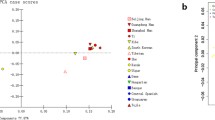Summary
Using a human dihydropteridine reductase (DHPR) cDNA, the frequency of restriction fragment length polymorphisms (RFLPs) with restriction endonucleases AvaII, MspI, NcoI and HinfI was estimated in unrelated, unaffected Japanese. The allele frequencies are different from those found in Caucasians, especially with MspI and HinfI. However, approximately 60% of Japanese are heterozygous for at least one of the RFLPs and analysis of one family with DHPR deficiency was shown to be informative. RFLP linkage analysis will be useful in the Japanese population as previously reported for Caucasians.
Similar content being viewed by others
References
Dahl, H. H. M., Hutchison, W., McAdam, W., Wake, S., Morgan, F. J. and Cotton, R. G. H. Human dihydropteridine reductase: Characterisation of a cDNA clone and its use in analysis of patients with dihydropteridine reductase deficiency.Nucleic Acids Res. 15 (1987) 1921–1932
Dahl, H. H. M., Wake, S., Cotton, R. G. H. and Danks, D. M. The use of restriction fragment length polymorphisms in prenatal diagnosis of dihydropteridine reductase deficiency.J. Med. Genet. 25 (1988) 25–28
Feinberg, A. P. and Vogelstein, B. A technique for radiolabelling DNA restriction endonuclease fragments to high specific activity.Anal. Biochem. 132 (1983) 6–13
Firgaira, F. A., Cotton, R. G. H., Danks, D. M., Fowler, K., Lipson, A. and Yu, J. S. Prenatal determination of dihydropteridine reductase in a normal fetus at risk for malignant hyperphenylalaninaemia.Prenat. Diagn. 3 (1985) 7–11
Kaufman, S. The phenylalanine hydroxylating system from mammalian liver.Adv. Enzymol. 35 (1971) 235–319
Kaufman, S., Holtzman, N. A., Milstein, S., Butler, J. J. and Krumholz, A. Phenylketonuria due to a deficiency of dihydropteridine reductase.N. Engl. J. Med. 293 (1975) 785–790
Lockyer, J., Cook, R. G., Milstien, S., Kaufman, S., Woo, S. L. C. and Ledleg, F. D. Structure and expression of human dihydropteridine reductase.Proc. Natl. Acad. Sci. USA 84 (1987) 3329–3333
Narisawa, K., Arai, N., Ishizawa, S., Ogasawara, Y., Onuma, A., Iinuma, K. and Tada, K. Dihydropteridine reductase deficiency: Diagnosis by leukocyte enzyme assay.Clin. Chim. Acta 105 (1980) 335–342
Niederwieser, A., Ponzone, A. and Curtius, H. C. Differential diagnosis of tetrahydrobiopterin deficiency.J. Inher. Metab. Dis. 8, Suppl. 1 (1985) 34–38
Smith, I., Hyland, K., Kendall, B. and Leeming, R. Clinical role of pteridine therapy in tetrahydrobiopterin deficiency.J. Inher. Metab. Dis. 8, Suppl. 1 (1985) 39–45
Wake, S., Hutchison, W. and Dahl, H. H. M. Ncol and HinfI RFLPs detected with a dihydropteridine reductase cDNA probe.Nucleic Acids Res. 16 (1988) 3124
Weeks, D. P., Veerman, N. and Griffith, O. M. A small-scale five-hour procedure for isolating multiple samples of CsC1-purified DNA: Application to isolations from mammalian, insect, higher plant, algal, yeast and bacterial sources.Anal. Biochem. 152 (1986) 376–385
Author information
Authors and Affiliations
Rights and permissions
About this article
Cite this article
Hayasaka, K., Narisawa, K., Ohura, T. et al. Restriction fragment length polymorphisms among Japanese detected with a dihydropteridine reductase cDNA gene probe. J Inherit Metab Dis 13, 873–878 (1990). https://doi.org/10.1007/BF01800212
Received:
Accepted:
Issue Date:
DOI: https://doi.org/10.1007/BF01800212




